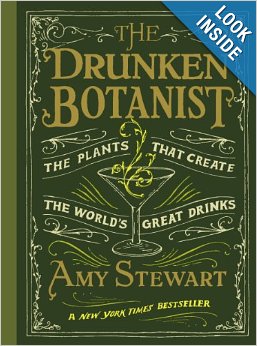 Whether you have an interest in botany or alcoholic beverages there is something in The Drunken Botanist book to enjoy. As the author, Amy Stewart, states “Every great drink starts with a plant” and the chapters that follow prove her point. By examining the role of plants including herbs, trees, flowers, fruits, vegetables, and fungi in the making of alcohol, Stewart introduces the reader to a fascinating account of how people have produced a variety of alcoholic drinks. Sprinkled with historical anecdotes and the debunking of myths, the book makes lively reading that can be enjoyed by a wide audience from gardeners to bartenders.
Whether you have an interest in botany or alcoholic beverages there is something in The Drunken Botanist book to enjoy. As the author, Amy Stewart, states “Every great drink starts with a plant” and the chapters that follow prove her point. By examining the role of plants including herbs, trees, flowers, fruits, vegetables, and fungi in the making of alcohol, Stewart introduces the reader to a fascinating account of how people have produced a variety of alcoholic drinks. Sprinkled with historical anecdotes and the debunking of myths, the book makes lively reading that can be enjoyed by a wide audience from gardeners to bartenders.
Part I of the book deals with the plants mostly commonly made into alcohol from agave to wheat with a section on brews. Stewart combines descriptions of plants and the liquor making processes with anecdotes from history and suggestions for sampling the brews. She notes, for example, that most of the tequila we drink in margaritas is not 100% from agave sugars and that the “real thing” is well worth sampling, needing no lime juice or salt. We also learn that vodka was originally made from grains but in 1945 grain shortages caused United States distilleries to become creative and use potatoes to make vodka. Every wondered why wheat beers are served with a wedge of lemon? The answer is here. The section on strange brews includes a ceremonial drink made from the monkey puzzle tree, beer from bananas, and wine from parsnips. Wine is also made from the sap of date palms and in Bangladesh and India bats compete with humans for the sap and spread a serious virus disease.
Part II considers the many different kinds herbs and spices used by distillers to enhance their products. Artichokes, maidenhair fern, and tobacco all have a place in the test as do opium poppies, douglas fir, and agaric, a shelf fungus. Of course, hops, coffee, and cherries play major roles with lots of good stories and interesting facts are included. No discussion of spirits could be complete without a look at juniper, and the many different kinds of gin that can be made from it. Add any one or more of eleven common flavorings from angelica root to lavender or cardamom, and the number goes even higher.
A discussion of spirits would not be complete without considering garnishes and other botanical mixers and Part II does so. Here is the information that will especially spark the interest of gardeners. Readers can learn how to brine their own olives, make their own grenadine, and infuse vodka with a favorite flavor. Growing notes and suggestions for using garden produce are given along with the good anecdotes that entertain. After reading this chapter you may never order a mojito in a bar that does not have fresh mint in evidence but you may be tempted to make lemoncello or a lavender martini.
The information in this book is reason enough to read it but the entertainment value makes it a classic good read. In addition to all the factual material on the nature of the plants and the processes involved in making the liquor the author includes recipes for a multitude of cocktails, explanations of terms, folklore, and interesting tidbits. Stewart’s sense of humor touches every page and makes it a delight to read as well as an education on drinks and the plants that created them.